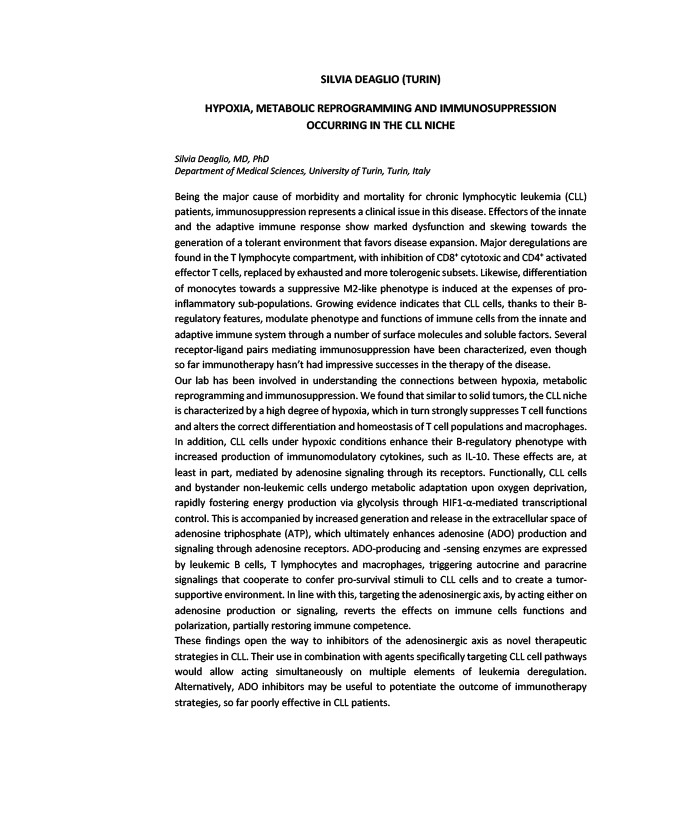
SILVIA DEAGLIO (TURIN)
HYPOXIA, METABOLIC REPROGRAMMING AND IMMUNOSUPPRESSION
OCCURRING IN THE CLL NICHE
Silvia Deaglio, MD, PhD
Department of Medical Sciences, University of Turin, Turin, Italy
Being the major cause of morbidity and mortality for chronic lymphocytic leukemia (CLL)
patients, immunosuppression represents a clinical issue in this disease. Effectors of the innate
and the adaptive immune response show marked dysfunction and skewing towards the
generation of a tolerant environment that favors disease expansion. Major deregulations are
found in the T lymphocyte compartment, with inhibition of CD8+ cytotoxic and CD4+ activated
effector T cells, replaced by exhausted and more tolerogenic subsets. Likewise, differentiation
of monocytes towards a suppressive M2-like phenotype is induced at the expenses of pro-inflammatory
sub-populations. Growing evidence indicates that CLL cells, thanks to their B-regulatory
features, modulate phenotype and functions of immune cells from the innate and
adaptive immune system through a number of surface molecules and soluble factors. Several
receptor-ligand pairs mediating immunosuppression have been characterized, even though
so far immunotherapy hasn’t had impressive successes in the therapy of the disease.
Our lab has been involved in understanding the connections between hypoxia, metabolic
reprogramming and immunosuppression. We found that similar to solid tumors, the CLL niche
is characterized by a high degree of hypoxia, which in turn strongly suppresses T cell functions
and alters the correct differentiation and homeostasis of T cell populations and macrophages.
In addition, CLL cells under hypoxic conditions enhance their B-regulatory phenotype with
increased production of immunomodulatory cytokines, such as IL-10. These effects are, at
least in part, mediated by adenosine signaling through its receptors. Functionally, CLL cells
and bystander non-leukemic cells undergo metabolic adaptation upon oxygen deprivation,
rapidly fostering energy production via glycolysis through HIF1-α-mediated transcriptional
control. This is accompanied by increased generation and release in the extracellular space of
adenosine triphosphate (ATP), which ultimately enhances adenosine (ADO) production and
signaling through adenosine receptors. ADO-producing and -sensing enzymes are expressed
by leukemic B cells, T lymphocytes and macrophages, triggering autocrine and paracrine
signalings that cooperate to confer pro-survival stimuli to CLL cells and to create a tumor-supportive
environment. In line with this, targeting the adenosinergic axis, by acting either on
adenosine production or signaling, reverts the effects on immune cells functions and
polarization, partially restoring immune competence.
These findings open the way to inhibitors of the adenosinergic axis as novel therapeutic
strategies in CLL. Their use in combination with agents specifically targeting CLL cell pathways
would allow acting simultaneously on multiple elements of leukemia deregulation.
Alternatively, ADO inhibitors may be useful to potentiate the outcome of immunotherapy
strategies, so far poorly effective in CLL patients.